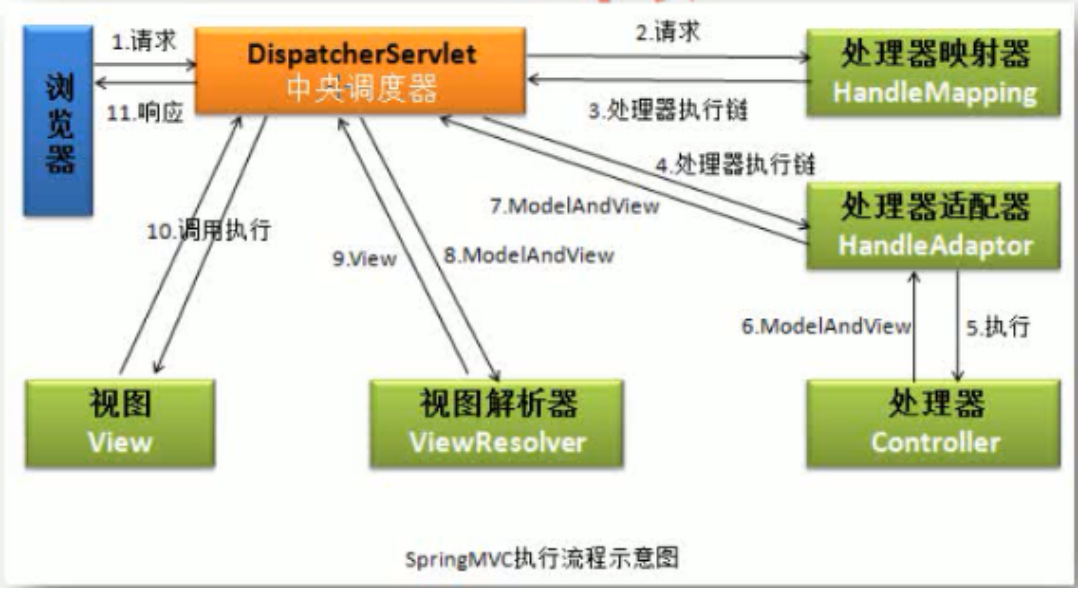HandlerMapping执行原理,如何找到controller
HandlerMapping在这个SpringMVC体系结构中有着举足轻重的地位,充当着url和Controller之间映射关系配置的角色。HandlerMapping是接口,Spring MVC提供了一系列HandlerMapping的实现,根据一定的规则选择controller。如果当前的HandlerMappign实现中没有能够满足你所需要的规则是,可以通过实现HandlerMapping接口进行扩展。它主要有三部分组成:HandlerMapping映射注册、根据url获取对应的处理器、拦截器注册。
HandlerMapping执行流程

HandlerMapping原理
1. HandlerMapping接口定义
package org.springframework.web.servlet;
public interface HandlerMapping {
HandlerExecutionChain getHandler(HttpServletRequest request) throws Exception;
}
2. AbstractHandlerMapping实现接口
AbstractHandlerMapping属性
// order赋了最大值,优先级是最小的
private int order = Integer.MAX_VALUE; // default: same as non-Ordered
// 默认的Handler,这边使用的Obejct,子类实现的时候,使用HandlerMethod,HandlerExecutionChain等
private Object defaultHandler;
// url计算的辅助类
private UrlPathHelper urlPathHelper = new UrlPathHelper();
// 基于ant进行path匹配,解决如/books/{id}场景
private PathMatcher pathMatcher = new AntPathMatcher();
// 拦截器配置:1,HandlerMapping属性设置;2,extendInterceptors设置
private final Listinterceptors = new ArrayList();
// 从interceptors中解析得到,直接添加给全部handler
private final ListadaptedInterceptors = new ArrayList();
// 使用前需要跟url进行匹配,匹配通过才会使用
private final ListmappedInterceptors = new ArrayList();
AbstractHandlerMapping拦截器初始化
@Override
protected void initApplicationContext() throws BeansException {
extendInterceptors(this.interceptors);
detectMappedInterceptors(this.mappedInterceptors);
initInterceptors();
}
/**
* 提供给子类扩展拦截器,可惜都没有使用
*/
protected void extendInterceptors(Listinterceptors) {
}
/**
* 扫描应用下的MappedInterceptor,并添加到mappedInterceptors
*/
protected void detectMappedInterceptors(ListmappedInterceptors) {
mappedInterceptors.addAll(
BeanFactoryUtils.beansOfTypeIncludingAncestors(
getApplicationContext(),MappedInterceptor.class, true, false).values());
}
/**
* 归集MappedInterceptor,并适配HandlerInterceptor和WebRequestInterceptor
*/
protected void initInterceptors() {
if (!this.interceptors.isEmpty()) {
for (int i = 0; i < this.interceptors.size(); i++) {
Object interceptor = this.interceptors.get(i);
if (interceptor == null) { throw new IllegalArgumentException("Entry number " + i + " in interceptors array is null"); }
if (interceptor instanceof MappedInterceptor) { mappedInterceptors.add((MappedInterceptor) interceptor); }
else { adaptedInterceptors.add(adaptInterceptor(interceptor)); } } } }
protected HandlerInterceptor adaptInterceptor(Object interceptor) {
if (interceptor instanceof HandlerInterceptor) { return (HandlerInterceptor) interceptor; }
else if (interceptor instanceof WebRequestInterceptor) { return new WebRequestHandlerInterceptorAdapter((WebRequestInterceptor) interceptor); }
else { throw new IllegalArgumentException("Interceptor type not supported: " + interceptor.getClass().getName()); } }
3. getHandler实现
public final HandlerExecutionChain getHandler(HttpServletRequest request) throws Exception {
Object handler = getHandlerInternal(request);
if (handler == null) {
handler = getDefaultHandler();
}
if (handler == null) {
return null;
}
// Bean name or resolved handler?
if (handler instanceof String) {
String handlerName = (String) handler;
handler = getApplicationContext().getBean(handlerName);
}
return getHandlerExecutionChain(handler, request);
}
protected HandlerExecutionChain getHandlerExecutionChain(Object handler, HttpServletRequest request) {
HandlerExecutionChain chain =
(handler instanceof HandlerExecutionChain) ?
(HandlerExecutionChain) handler : new HandlerExecutionChain(handler);
chain.addInterceptors(getAdaptedInterceptors());
String lookupPath = urlPathHelper.getLookupPathForRequest(request);
for (MappedInterceptor mappedInterceptor : mappedInterceptors) {
if (mappedInterceptor.matches(lookupPath, pathMatcher)) {
chain.addInterceptor(mappedInterceptor.getInterceptor());
}
}
return chain;
}
封装拦截器到HandlerExecutionChain,HandlerExecutionChain中只包含一个handler。包含N个拦截器,把这个对象返回给了中央调度器。其中adaptedInterceptors是直接添加,mappedInterceptors需要根据url匹配通过后添加
HandlerMapping总结
HandlerMapping是处理器映射器,根据请求找到处理器Handler,但并不是简单的返回处理器,而是将处理器和拦截器封装,形成一个处理器执行链(HandlerExecuteChain)。
HandlerMapping执行流程如下:
DispatcherServlet
--->doDispatcher()
---->getHandler(request):
---->HandlerExecutionChain
------> hm.getHandler(request)-----》方法体中
----->ExecutionChain executionChain = getHandlerExecutionChain(handler, request);
----->new HandlerExecutionChain(handler)
----->chain.addInterceptor(interceptor);
版权声明:本文为JAVASCHOOL原创文章,未经本站允许不得转载。

